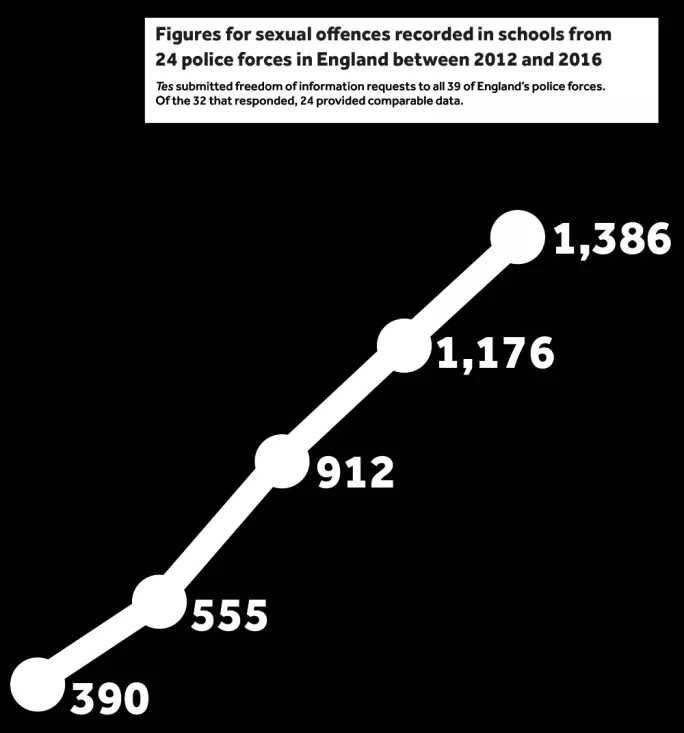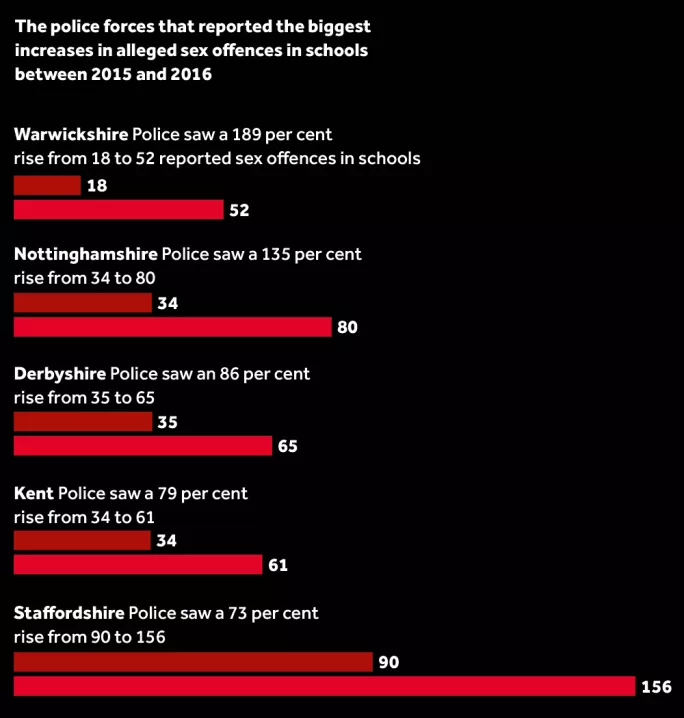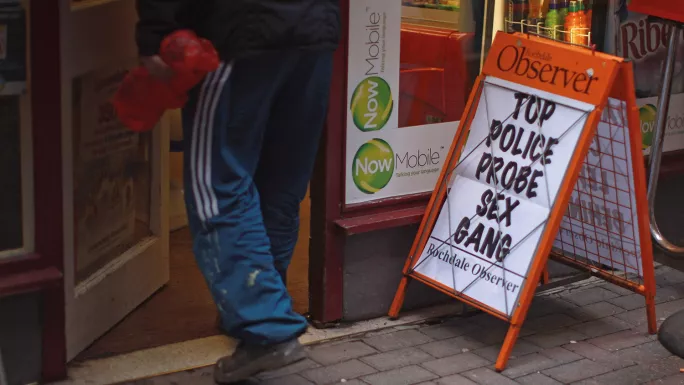255% up: the epidemic of sex offences in schools

The sexual harassment and abuse of female pupils in schools is “being accepted as part of daily life”, MPs have warned.
“Children of primary school age are learning about sex and relationships through exposure to hardcore pornography,” September’s shocking report from the Commons Women and Equalities Committee continued. “Teachers are accepting sexual harassment as being ‘just banter’.”
Now new police figures, obtained by Tes, show the full extent of the problem. They reveal that the annual number of sexual offences reported in schools has more than tripled in four years.
Freedom of information requests were submitted to all 39 of England’s police forces. Of the 32 that responded, 24 provided comparable data. It shows that:
* The annual number of sex crimes reported in schools rose by 255 per cent in four years;
* In 2016, the number of alleged sex offences in schools increased by 18 per cent compared with 2015;
* In one area the number nearly trebled with a 189 per cent rise;
* Overall, the figures suggest that teachers as well as pupils have been victims, with about one in 10 of the crimes committed against adults.
The rise could partly be a result of increased awareness and reporting. However, children’s charities and teaching unions believe online pornography and sexualised videos - which are easier for pupils to access on mobile devices - are also to blame.

The breakdowns of the types of offence provided by some police forces appear to back that up. They suggest that “obscene publications [pornography]” offences in schools more than doubled from 2015 to 2016.
‘Horrifying’ figures
“School leaders will be horrified at the increase of the figures,” Geoff Barton, general secretary of the Association of School and College Leaders, says. “They will feel all the more need to make sure these things are proactively dealt with and reactively dealt with - in terms of sex education and disciplinary policies.”
But why are the numbers still climbing and what can schools do to tackle the issues?
Two-thirds of the 24 police forces that provided comparable figures saw a rise in sex offences in schools last year compared with 2015. Some areas of the country saw the number of reported sex crimes more than double. The figures do not include England’s three biggest police forces because they all submitted data for “educational establishments” that could include universities and colleges, as well as schools. But with sex offences across all education institutions rising by 28 per cent in London, 26 per cent in Greater Manchester and 24 per cent in the West Midlands between 2015 and 2016, the trend is the same.

Norfolk chief constable Simon Bailey, the National Police Chiefs’ Council lead for child abuse, says the rising number of sexual offences in schools could be partly due to more victims being prepared to report the crimes. But he also notes that it is “clear that the increased availability of sexualised material, such as online pornography, poses a real threat to young people”.
Jon Brown, the head of impact and development at NSPCC, takes a similar view, pointing to the sexualisation of young people through advertising and music videos. “We think that the real-terms increase could be due to the ease of availability of pornography online,” he adds. “For some young people, that can have undue influence in terms of sexually abusive and sexually aggressive behaviour.
“The majority of young people who do view pornography online are able to make a clear differentiation between viewing that and their real-life sexual behaviour. But for some young people, they are not able to do that - so we think that could be a driver.”
There is evidence that the government is now taking the issue seriously. In November, following the scathing report from the Commons Women and Equalities Committee, it acknowledged that the scale of sexual violence and harassment in schools was “worrying”. The government pledged to set up an advisory group to review the guidance in place for schools and has since followed the committee’s recommendation and decided to make sex and relationships education compulsory in all schools.
Unions and charities have welcomed the changes. But they remain concerned about the wider problem.
The police figures show that the largest year-on-year rise in the number of alleged sex offences in schools over the past four years was from 2013 to 2014, when the number of reported crimes rose by 64 per cent.
‘Increased reporting’
Lucy Russell, campaign manager for children’s charity Plan UK, believes this spike may have something to do with events outside schools. She points to sexual abuse allegations, predominantly concerning the abuse of children, against Jimmy Savile. They came to light at the end of 2012, sparking investigations into other media personalities.
At around the same time, the child exploitation scandals in Rotherham, Rochdale and Oxford were also reported widely across the media. Russell argues that the coverage of these events may have driven the increase in the number of reported sexual offences in schools from 2013 to 2014.

“I think that it did have a positive effect on increased reporting and it quite often gave young people the vocabulary to talk about it,” she says.
The charity has also been collecting its own evidence since 2013, and found that a significant amount of sexual harassment and sex offences had been occurring in schools across the UK. “Young people were saying, ‘This has become a culture in our classroom, in the corridors and behind the buildings. We don’t feel safe in schools,’” Russell says. “[They felt] it was just something you had to put up with and it was just something that happened.” Mary Bousted, general secretary of the ATL teaching union, is also concerned about “a very serious and increasing problem” of sexual harassment of girls in schools.
“I think we are going backwards rather than forwards when it comes to equality for girls and women,” she says. Barton thinks phone bans in schools could be a solution: “That seems to me a really important strategy, because it then discourages any use of a mobile phone to film something inappropriate,” he says. “That is made much easier if you have a blanket ban across the whole school which is enforced from the management down.”
But at the NSPCC, Brown warns that it is not uncommon for schools to bury their heads in the sand and deny they have a problem with sexual offences, rather than taking proper steps to address it.
“There can be a temptation for schools to underestimate the scale of the problem or to ignore the problem sometimes,” he says.
“All schools are going to have it to a greater or lesser extent. When you hear schools say, ‘We don’t have that problem so we don’t need to address it’ - and we do sometimes hear it in as frank terms as that - then that raises concerns. That would ring an alarm bell for us.”
You need a Tes subscription to read this article
Subscribe now to read this article and get other subscriber-only content:
- Unlimited access to all Tes magazine content
- Exclusive subscriber-only stories
- Award-winning email newsletters
Already a subscriber? Log in
You need a subscription to read this article
Subscribe now to read this article and get other subscriber-only content, including:
- Unlimited access to all Tes magazine content
- Exclusive subscriber-only stories
- Award-winning email newsletters